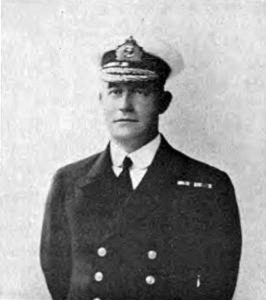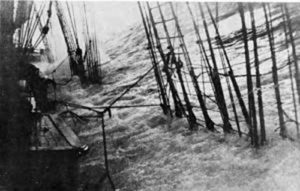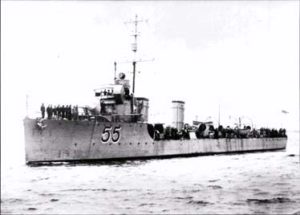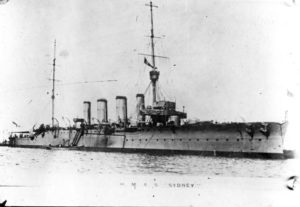By Lieutenant Commander A.W. Grazebrook
First published in the June 1974 edition of the Naval Historical Review.
The majority of the more senior retired officers of the Royal Australian Navy consider that the late Admiral Sir George Francis Hyde was the foremost of a group of early senior members of the Permanent Naval Force who joined in early years from a variety of seafaring backgrounds.
 After early years in the merchant service and as a Royal Naval Reservist, Hyde entered the Royal Navy as a Lieutenant. After transferring to the Royal Australian Navy, Hyde rose to become the first member of the PNF to fly his flag afloat in command of the Australian Squadron, the first member of the PNF to command a ship of the Royal Navy, the first and only RAN Flag Officer to fly his flag afloat in command of a Royal Navy Squadron, the only RAN Officer to be created KCB, the first member of the PNF to achieve the rank of full Admiral on the active list, and the first seagoing flag officer of the RAN to become professional head of his service.
After early years in the merchant service and as a Royal Naval Reservist, Hyde entered the Royal Navy as a Lieutenant. After transferring to the Royal Australian Navy, Hyde rose to become the first member of the PNF to fly his flag afloat in command of the Australian Squadron, the first member of the PNF to command a ship of the Royal Navy, the first and only RAN Flag Officer to fly his flag afloat in command of a Royal Navy Squadron, the only RAN Officer to be created KCB, the first member of the PNF to achieve the rank of full Admiral on the active list, and the first seagoing flag officer of the RAN to become professional head of his service.
 George Francis Hyde was born at Portsmouth on 19th July 1877. At the age of 17, he went to sea as an apprentice in the steel clipper Mount Stewart, completing several round voyages from London to Sydney, with wool as the westward cargo and general cargo to Australia. It was a tough start to a seafaring lifetime, at a time when the going rate for an apprentice was three pounds per annum. Hyde’s diaries, describing part of his time in Mount Stewart, have been preserved in part and make interesting reading in much the same way as a Midshipman’s journal – descriptions of nautical events of the passage, other ships sighted, and different types of fauna noted. Wool clippers took substantially longer than modern merchantmen to make the round voyage. Hyde describes one round voyage from London to Sydney and back of over ten months’ duration.
George Francis Hyde was born at Portsmouth on 19th July 1877. At the age of 17, he went to sea as an apprentice in the steel clipper Mount Stewart, completing several round voyages from London to Sydney, with wool as the westward cargo and general cargo to Australia. It was a tough start to a seafaring lifetime, at a time when the going rate for an apprentice was three pounds per annum. Hyde’s diaries, describing part of his time in Mount Stewart, have been preserved in part and make interesting reading in much the same way as a Midshipman’s journal – descriptions of nautical events of the passage, other ships sighted, and different types of fauna noted. Wool clippers took substantially longer than modern merchantmen to make the round voyage. Hyde describes one round voyage from London to Sydney and back of over ten months’ duration.
After four years in Mount Stewart, Hyde joined the barque Amulree as second mate in 1898. Amulree sailed to South America and Australia. Hyde remained in her until 1899.
Angry seas sweep the deck of the three-masted sailing ship Mount Vernon as she rounds Cape Horn. Admiral Hyde sailed in this vessel as an apprentice in 1877.
During his apprenticeship in 1896, Hyde joined the Royal Naval Reserve as a Midshipman. In January 1900, by then an Acting Sub-Lieutenant, Hyde joined the Gunnery School HMS Excellent for the first of a series of courses to qualify as a confirmed Sub-Lieutenant, RNR. In February 1901, Hyde joined HMS Tribune, in which he served for 15 months before transferring to HMS Thistle for ten days only. Hyde moved to the battleships Magnificent (1902) and Victorious(1902-04), having been promoted Lieutenant, RNR, in 1902, and serving full time as such until 1904.
It was whilst in Victorious that Hyde wrote an essay on the subject of ‘War with Japan’, with particular reference to the Russo- Japanese War, and entered that essay for a prize offered by Lord Charles Beresford to the officers of his Lordship’s Fleet for the best essay on that subject. Hyde was clearly the winner of the competition, which as he was a Lieutenant RNR, made a very favourable impression upon his Commander in Chief, Admiral Lord Charles Beresford.
Lord Charles wrote a very strong recommendation to the Admiralty that Hyde be entered in the Royal Navy with his seniority as Lieutenant RNR. Thus, it came about that, contrary to some reports, Hyde did not enter the Royal Navy as one of the ‘Hungry Hundred’, and was not placed under the publicly stated limitations for promotion that were imposed upon that group of RNR Officers who transferred to the Royal Navy at about the same time as Hyde.
After three months in the cruiser HMS Bacchante, Hyde began two years as a watchkeeper in the Armoured Cruiser HMS Leviathan, flagship of Rear Admiral the Hon. Hedworth Lambton’s Third Cruiser Squadron in the Mediterranean Fleet. Hyde’s first and second commands followed (HM Torpedo Boat Number Six for 15 months, and the Torpedo Boat Destroyer Pother for 13 months).
 Hyde’s first association with the newborn RAN began as soon as he left HMS Shannon, when he was appointed Commander (D) to the RAN’s destroyer flotilla, then being formed. Hyde made a very favourable impression upon the then Naval Board as, early in 1912, he was approached and asked to transfer to the Royal Australian Navy on a permanent basis. In due course, Hyde was formally placed on the retired list of the Royal Navy, and on 17th July 1912 Hyde became a Commander, RAN, with seniority of 1st January 1911 (the date he first became associated with the RAN’s destroyer flotilla). His first RAN ship was HMAS Parramatta.
Hyde’s first association with the newborn RAN began as soon as he left HMS Shannon, when he was appointed Commander (D) to the RAN’s destroyer flotilla, then being formed. Hyde made a very favourable impression upon the then Naval Board as, early in 1912, he was approached and asked to transfer to the Royal Australian Navy on a permanent basis. In due course, Hyde was formally placed on the retired list of the Royal Navy, and on 17th July 1912 Hyde became a Commander, RAN, with seniority of 1st January 1911 (the date he first became associated with the RAN’s destroyer flotilla). His first RAN ship was HMAS Parramatta.
Early in 1913, Hyde left for the United Kingdom to become Executive Officer of the battle cruiser HMAS Australia, then completing to become the RAN’s first flagship. Hyde participated in Australia’s activities in the early months of World War I, in the Pacific and the West Indies, leaving the ship three months after she hoisted the flag of Rear-Admiral W. C. Pakenham (Commanding Second Battle Cruiser Squadron) at Rosyth in February 1915.
In July 1915 Hyde was appointed in command of the light cruiser HMS Adventure. That ship served in the English Channel and in patrol and escort work in the Western Approaches as the Flagship of Admiral Sir Lewis Bayly, who commanded in chief in that area. Hyde, in addition to being Flag Captain, was also Chief Staff Officer, an invaluable experience. He became a substantive Captain on 1st April 1917, having acted in the rank of Captain since assuming command of Adventure, the first officer of the RAN to command a Royal Navy Ship.
After a very demanding 3½ years’ service at sea in war time, Hyde was moved for six months to the Mercantile Movements Division in which the Naval Board functions. This period also saw Hyde acting as First Naval Member during periods of absence on the part of the normal holder of that position. This experience was to prove invaluable to Hyde in later years, during his service as First Naval Member.
Courses in the United Kingdom preceded Hyde’s next command, that of the cruiser HMS Vindictive, serving in British waters.
At the end of 1925, Hyde returned to Australia and on 30th April 1926 hoisted his broad pennant as Commodore (1st Class) Commanding the Australian Squadron in HMAS Sydney. Hyde remained in command of the Squadron after his promotion to Rear Admiral (23rd February 1928) until he hauled down his flag in May 1929.
 Hyde’s period in command of the Squadron was typical, in many respects, of peacetime service life of the day – a Royal Navy Cruiser on exchange, cruises to the New Hebrides, Hobart, and many other places, exercises off Hervey Bay and Jervis Bay, destroyers rotating in commission, regattas, support for civil authorities in time of natural difficulties such as bush fires.
Hyde’s period in command of the Squadron was typical, in many respects, of peacetime service life of the day – a Royal Navy Cruiser on exchange, cruises to the New Hebrides, Hobart, and many other places, exercises off Hervey Bay and Jervis Bay, destroyers rotating in commission, regattas, support for civil authorities in time of natural difficulties such as bush fires.
Highlights of Hyde’s period of command of the Squadron included escorting the battle-cruiser HMS Repulse when that ship conveyed Their Royal Highnesses, the Duke and Duchess of York, on a visit to Australia. For his service to his future King during the visit, Hyde was created CVO.
As the new heavy cruisers HMA Ships Australia and Canberra neared completion in the United Kingdom, Hyde shifted his broad pennant to HMAS Melbourne and left for the United Kingdom with that ship carrying officers and sailors for the new cruisers. It was during the voyage to Europe that Hyde was promoted Rear Admiral. In May 1928, Hyde hoisted his flag in HMAS Australia, the first of a long line of Flag Officers to fly their flags in this ship. After HM King George V had visited both Australia and Canberra at Portsmouth, Hyde’s flagship left for home via North America, whilst Canberra came home via South Africa. Australia’s voyage included visits to Canada, Boston, New York, Annapolis and New Zealand before arrival at Brisbane.
After relinquishing command of the Squadron, Hyde was married in 1929 to Miss Isla Robertson, daughter of Mr. M. Robertson of Jandra, NSW. Best man at his wedding was Lieutenant Commander (now Captain RAN retired) J. B. Foley, CBE, RAN. Foley had been appointed Secretary to Commodore Hyde when the latter became Second Naval Member in 1923, and continued to serve with Admiral Hyde in every major post – both ashore and afloat, at home and abroad, thereafter. This was a very remarkable association lasting for 14 years.
After taking leave due, Hyde proceeded to the United Kingdom to hoist his flag in the battleship Emperor of India as Rear Admiral of the Royal Navy’s Third Battle Squadron.
During his period of command, Hyde shifted his flag to the battleship HMS Marlborough.
This command, of a main fleet battle squadron of the Royal Navy, was indicative of the very high regard in which Hyde was held not only in Australia, but also in the United Kingdom.
Hyde took advantage of this visit to the United Kingdom to visit many Royal Navy shore installations and, particularly, to see as much as he could of the functions and personnel of the Admiralty. Hyde served as Australia’s naval adviser at the 1930 London Naval Treaty Conference. After a period in the Admiralty, gaining knowledge of the functions of various Admiralty Divisions, Hyde returned to Australia and in October 1931 became First Naval Member of the Commonwealth Naval Board – the professional head of the RAN. Promotion to Vice Admiral came in November 1932, and to full Admiral on 12th July 1936 – the first seagoing member of the RAN to hold this rank and office. In the 1937 New Year Honours, Hyde was created KCB, the only RAN Officer ever to achieve that honour.
Hyde’s period as First Naval Member was probably the most difficult and frustrating of his whole life. Economic problems resulted in the Government of the day running down the strength of the RAN, in fact, of all the defence services. Hyde had to preside over the paying off of the new seaplane carrier HMAS Albatross, the disbandment of the RAN’s submarine service and the premature discharge of 700 officers and sailors. He even had to fight off suggestions of the total disbandment of the RAN, made in the Parliament by some members of the then Labour Opposition. It was a difficult task to maintain morale and a small but solid base of 3,000 trained personnel upon which the RAN could be rebuilt for World War II. It is greatly to Hyde’s credit that he overcame the transition from command afloat to the very different political and public service surroundings of Melbourne and played a leading part in the early stages of rebuilding the RAN, towards the end of his period as the professional head of his service.
Hyde’s conviction that the RAN would be needed was reinforced by what he learned when he served as adviser at the 1935 London Naval Conference. Hyde’s foresight enabled him to recognise that war with Germany was a virtual certainty, and that with Japan probable. This knowledge was a driving force in Hyde’s claim that the RAN needed modern cruisers, and in the many other steps that Hyde took during the last two years before his death.
Hyde saw the replacement of the ageing cruiser HMAS Brisbane by the new HMAS Sydney, the acquisition of five replacement destroyers for the ‘S’ Class, and an increase in personnel which facilitated the retaining in commission of a higher proportion of the Fleet.
A firm but just man, Hyde had the naval officer’s traditional dislike of publicity. Hyde’s modesty must have made political and public service surroundings as difficult for him as they are for many other naval officers. Hyde was wholly committed to the RAN, for which he worked unremittingly. For Hyde, every day except Christmas Day, Good Friday, and Sundays, were normal working days. As can be imagined, a similar devotion was expected of, and gladly given, by his personal staff, to whom he could and did show great personal kindness.
Hyde had been appointed originally as First Naval Member for a period of five years. This was subsequently extended for a further one year. Accordingly, early in 1937 arrangements were made for Hyde to be replaced by Vice Admiral Sir Ragnar Colvin, late in 1937. However, in mid July, Hyde developed bronchial pneumonia and died on the afternoon of 28th July, in a Melbourne private hospital. His modesty remained with him to the end – at his own request his funeral at Springvale was private, with no flowers.
By any measure, Hyde’s career was successful in command afloat and as professional head of his Service. The rank of full Admiral in the RAN has been achieved by only two officers during the 60 years of the RAN’s existence. It was to be 33 years after Hyde’s death before the first graduate of the RAN College climbed the full height of the RAN ladder to become a full Admiral RAN – Admiral Sir Victor A. T. Smith, KBE, CB, DSC, was promoted to that rank on 23rd November 1970, when he became Chairman of the Chiefs of Staff Committee.




